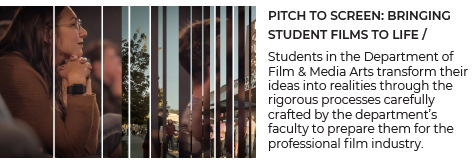Student Ailish Harris (left) and guest artist Matt Sorensen (right) construct a dragon for “She Kills Monsters.” (Photo: Todd Collins)
WRITTEN BY EMERI FETZER
For a production designer, a script that includes fantasy roleplaying, epic battles, menacing monsters, and 90’s pop culture is an utter playground for the imagination, and an enticing opportunity to use novel tools in bringing a stylized world to life.
This year, the University of Utah Department of Theatre presented Qui Nguyen’s “She Kills Monsters,” the story of Agnes Evans, a young woman grieving for her deceased sister. The Evans sisters were never very close, but after Tilly’s death, Agnes finds a notebook containing a game scenario created by her sister. She discovers that Tilly was a well-known Dungeons and Dragons player. To find out more about Tilly and her mysterious community, Agnes recruits a “dungeon master” named Chuck to help her play the game.
Students in the Performing Arts Design Program (PADP) had to think larger-than-life to deliver both the epic adventure and cheeky humor of the Dungeons and Dragons world — one swarming with monsters like Kobolds, Bugbears, a Gelatinous Cube, a Beholder, and even a five-headed dragon. The large scale of Kingsbury Hall, where the play would be produced, further amplified the need for big, bold choices. As they began to strategize, the design team dreamt up striking shadow sequences and dramatic lighting, and a set featuring stone castle walls.
But to tackle monster-making, PADP Head and Associate Professor, Brenda Van der Wiel, called upon New York based puppet artist Matt Sorensen. Sorensen, approaching completion of his MFA in Puppetry from University of Connecticut, joined Van der Wiel as a guest artist for nearly half of the her fifteen-week design course in puppet making. In the past, the costume crafts class has covered everything from armor to horns, millinery to wings, depending on the needs of the upcoming performance season. This fall, building D&D’s fantastical beasts was the sole focus.

Left image: (Left to right) students Dani Lincoln and Kiersten Farley at work on The Beholder puppet. (Photo: Todd Collins)
Right image: Student Connor Johnson in armor. (Photo: Todd Collins)
While some students were experienced in theatrical design, others came from stage management, computer science, and writing programs, bringing an exciting blend of diverse perspectives.
“Many of the students were unfamiliar with the script, and I don’t know what they were expecting, but when most people hear they will be building puppets, they are likely thinking about foam and fabric hand puppets like the Muppets; small, cute, and manageable,” Sorensen said. “I think many of the students were surprised to find how unique and widely varied each of the puppets for this production are. There was no uniform cookie-cutter process for what we were asking them to accomplish.”
Sorensen, Van der Wiel, and the students crafted puppets from a light, durable material called ethafoam and PVC pipe for structure. Because battle scenes required sweeping movement and aggressive stage combat, the monsters needed to be both long-lasting and pliable. The puppets were finished with paint, fabric and leather details, and even LED lights for special effects.
Throughout the process, students were encouraged to consistently think about how the puppets would move on stage. “Some of the puppets are wearable, so you have to consider not only how they fit the performers, but those performers’ physical safety as well. Can they see clearly? Can they move their bodies in a healthy way without risking injury? My students had to incorporate these types of problem-solving skills into the process, along with learning new construction techniques and using unusual materials,” Sorensen described.
Not unlike most artistic practices, design is best learned through doing. While many assignments in college don’t extend past grading, the results of theatrical design courses are presented for live audiences, and both collaborators and performers count on their completion and quality. Van der Wiel holds that diving into real scenarios is what best prepares emerging production designers for work post-graduation.


(Left to right) student Connor Johnson, guest artist Matt Sorensen, student Ailish Harris, and PADP Area Head Brenda Van der Wiel. (Photo: Todd Collins)
“It’s a business where you constantly evolve,” she says. “I think the biggest thing for students is the ability to keep learning. You need a certain level of skill that you can build on, but designers need a questioning mindset.”
She also hopes that students will become accustomed to creative problem solving with limited resources.
“I’m trying to let them open their minds and think broadly, and not let a budget stifle their imaginations. Really creative things can be done with a limited budget. If you shut down your imagination, you will never get to the most creative solutions,” she said.
Beyond the designers, incorporating puppetry also allowed the cast of performers to expand their awareness, agility and strength. From developing a character while fully masked, to navigating the added weight of a wearable puppet in both dance and fight choreography, actors developed new skill sets throughout the production. With strong acting as the core focus, design and performance work synergistically to communicate the emotional core of the story.
“The beauty of theatre is that you can take a myriad of different approaches to telling the same story, and if they are produced in earnest, they can each be effective and compelling,” Sorensen said.
For this particular production, puppets were just the thing.
“Puppetry touches our hearts in a unique way, transcending the barriers that exist within live human storytelling,” Sorensen said. “It can enhance a production in many ways that other elements of live theatre can’t, but we still use the same time-honored theatrical storytelling techniques.” ■













